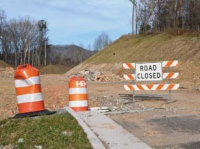Research outpost engages scientists and students under backdrop of the Smokies
There are few places where scientists probing the mysteries of the natural world would rather be.
The sweeping vistas of the Appalachian Highlands Science Learning Center, a remote outpost straddling the Cataloochee Divide, has lured researchers from across the globe to explore the Great Smoky Mountains National Park just outside the station’s door.
Since its addition to the park in 2000, the site at Purchase Knob has become a crown jewel of the national park. The outpost is not only a conduit for research in the park, but provides children in neighboring communities with a window on the natural world. The research station provides an intersection for scientists and students to come together, fulfilling one of its missions of citizen science.
Nearly 5,000 middle and high school students funnel through Purchase Knob on field trips and internships every year, contributing in real ways to scientific research. The researchers themselves often don’t have the financial staying power to gather data year after year.
“A lot only have funding for only one season,” said Park Ranger Susan Sachs, the education coordinator for Purchase Knob.
But sixth-graders visiting Purchase Knob for science fieldtrips have been testing the acidity of soil for seven years now. When they started, the soil averaged a pH of 5.5. Today it hovers between 5 and 4.5 — a trend likely due to acid rain from air pollution.
“We have seen a steady slow decline in our soil pH,” Sachs said.
Students also probe the decomposing leaf litter for insects in the woods surrounding Purchase Knob, counting their finds, examining them under a microscope and then releasing them unharmed back into the forest. With several dozen classes conducting the hunt year in and year out, the data piling up could be a harbinger of environmental changes.
“Over time, especially with climate change, some of these things are going to start changing. We might realize one day ‘When’s the last time you saw a wood roach?’” Sachs said. “We are kind of like a watchdog.”
Not to mention the free labor.
“Sometimes we might have a request from a researcher that says ‘Can you take a group out and do this?’” Sachs said.
Such was the case when scientists were looking for a new species of springtail, a type of insect with a spring board jumping mechanism in its tail. Students working with Sachs found a specimen that appeared to be a new species, but scientists never found another, leaving them to wonder if it was truly a new species or a genetic mutation.
“It was considered a discovered but lost species,” Sachs said. At the request of researchers, Sachs unleashed students to search the woods where the lone specimen had been found and told them to hit up all the springtails they could find.
“They found several to the delight of the researcher,” Sachs said. “It turns out the springtail was a ‘lost’ species that had only been found once before in 1954 in New York state. It’s rediscovery allowed it to finally become a legitimate species.”
High school interns play a vital role in air pollution research at Purchase Knob that measures the impact of ozone on vegetation. The students make daily forays into rows and rows of cut-leaf coneflower and crownbeard — dubbed the ozone garden — to chart the appearance of leaves. As the summer progresses, the sensitive leaves develop purplish spots, wither and die prematurely.
“The researchers are only here one to two weeks during the summer but they want to know ‘When did you first start to see the spots, and once you saw them how quickly did they progress,’” Sachs said. The students record their scientific observations.
Several teachers in the region have jumped on board, planting ozone gardens at their schools. At these lower elevations where ozone pollution is not as bad, the plants don’t suffer the same ailments. Students log their observations into an on-line database, allowing them to compare their gardens to those at Purchase Knob and of those at other schools.
The students learn the scientific method while doing research, as well as gain an appreciation for the ecosystem and its vulnerabilities.
“It gives what they have to learn in the classroom a real world application, a picture in their mind they can refer back to,” Sachs said. “It will answer the ‘so why should I care about this?’ question. They have a connection to something they really do care about.”
The gift of a lifetime
The reality of a research outpost like Purchase Knob could never have been realized without the initial benefactors, Kathryn McNeil and Voit Gilmore.
The two first came into the property by sheer happenstance back in 1964. Gilmore, a prominent businessman and statesman from Southern Pines, N.C., was hunting for commercial property to start an RV park in Maggie Valley when his real estate agent insisted on showing him the Purchase. Gilmore humored the agent and ventured up the mountain for a gander, but was hardly in the market for 500-some acres. He was so taken by the beauty and views, he immediately flew back to Southern Pines to fetch McNeil, who had just given birth to their fifth child. McNeil, too, fell in love.
“We both agreed we had to buy it,” McNeil said.
They built a vacation house on it the following year and it became a family retreat. As the children grew up, however, family visits became less frequent. McNeil summered there, but by the 1990s had tired of spending long weeks alone on the top of a mountain.
“I really thought it was time to give it away,” said McNeil, who’s now 88. “My husband and I knew what would happen if we sold it. It would become a country club or something and we didn’t want that to happen. It was too special.”
Since the property abutted the national park, McNeil called the superintendent of the Smokies at the time, Randy Pope, and invited him for a visit.
“He came and looked at it and said ‘We’ll take it.’ There was no doubt,” McNeil said. “They were so thrilled. They really didn’t know what they were going to do with it, but they knew they needed it. It was just a matter of details.”
Those details took another eight years to accomplish, however. Despite best intentions, the park service — like any federal agency — can become ensnared in its own unwieldy bureaucracy.
And there was still the looming question of what to do with the magnificent property. Along the way, a new superintendent, Karen Wade, arrived in the Smokies. Wade is credited with the idea of a research station where scientists and school children could converge. She developed a brochure outlining the vision, primarily to garner support in surrounding communities.
By happenstance, park officials visiting from Washington, D.C., saw the brochure. They liked the idea so much they began laying plans for a network of research and education centers in national parks across the country. The Smokies suddenly found itself competing against other parks for money to implement its vision at Purchase Knob, but was ultimately chosen as one of five pilot parks to test the idea.
“The Smokies has always had strong connections with research. It is typically the park that has the most research permits in the entire country. We are always in the top three,” Sachs said. The Smokies was also surrounded by public schools, unlike parks out West where neighboring communities are few and far between.
Sachs came on board with the Smokies in 1999 to help develop the education programming for the new Purchase Knob. Sachs tailored programs at the Purchase for middle and high school students and assembled a task force of teachers from the region to help develop a program that would meet their curriculum mandates.
The Purchase continues to be heralded throughout the park service as a model to replicate. Sometimes it seems Sachs spends more time on the speaking circuit than at her own park, leading seminars on how to integrate research and education. There are now 17 research learning centers across the national park system, from Acadia National Park to Point Reyes National Seashore.
Purchase Knob encompasses 530 acres of high-elevation rolling meadows and woodlands, surprisingly gentle terrain for its 4,900-foot altitude. The home built by McNeil and her husband serves as quarters for visiting researchers. When scientists lining up their visit hear the words “park quarters,” they expect little more than a bunk house or cabin, but instead find a mountain top lodge with wrap around decks, sweeping vistas, expansive windows, a giant dining room table and elegant living room.
“It is a beautiful place and inspirational setting coupled with comfortable meeting space and great natural resources,” Sachs said.
The allure of the Purchase could be the tipping point for scientists deciding where to do their research, which in turn benefits understanding of the park over time. “The park has tremendous natural resources they don’t always understand because natural systems are complicated,” said George Ivey, a grant writer for Friends of the Smokies.
One such experiment is a joint venture between NASA and Duke University that required launching weather balloons every three hours around the clock from the meadows at Purchase Knob. The goal: to better understand the microstructure of rainfall in the upper atmosphere and ultimately improve storm predictions.
“It was a very intensive experiment,” said Olivier Prat, one of nine researchers who descended on the Purchase for the project for a week last summer. “It’s important to have a facility like this where we could rest and work.”
As for McNeil, she lives in her hometown of San Francisco now, but flies back to Haywood County every year to visit the Purchase.
“I always have a little picnic lunch with the rangers and see what’s new and different that they’ve added,” McNeil said. “The Purchase is really still part of me. It has had a tremendous effect on my life like nothing else has.





